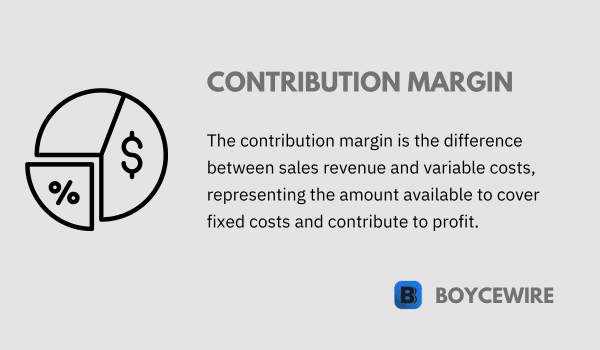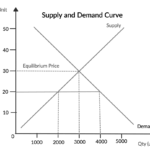Contribution Margin: Definition, How to Calculate & Examples

What is Contribution Margin?
In the dynamic world of business, understanding key financial indicators is essential for effective decision-making. One such crucial metric is the Contribution Margin. This financial concept plays an indispensable role in determining the profitability of individual items sold by a company and informs critical decisions about pricing, production quantities, and product lineups.
The contribution margin is a cost accounting concept that lets a company know how much each unit sold contributes to covering fixed costs after all variable costs have been paid. It can be calculated on a per-unit basis, or as a ratio, often expressed as a percentage.
Key Points
- The contribution margin is a financial metric that represents the amount of revenue remaining after deducting variable costs.
- It helps assess the profitability of individual products or services by measuring their contribution to covering fixed costs and generating profit.
- A higher margin indicates a higher proportion of revenue available to cover fixed costs and contribute to profit.
Understanding Contribution Margin
The contribution margin is a profitability metric that measures how selling a particular product affects a company’s operating income. It is calculated as the selling price per unit, minus the variable cost per unit. In other words, it signifies the ‘contribution’ each unit of a product makes to the company’s profits once the variable costs – costs that change in proportion to the volume of goods produced – have been covered.
A positive margin means that a product’s price exceeds its variable costs, and it contributes to covering the fixed costs and then to the profit. On the other hand, a negative margin indicates that a product is sold for less than the variable costs associated with its production and sale.
It’s important to note that contribution margin is different from gross margin. While the former considers only variable costs, the latter takes into account both variable and fixed costs.
There are three ways to express the contribution margin (CM):
- Per unit CM The revenue remaining per unit after subtracting the variable costs associated with producing that particular unit.
- Total CM The total earnings available to cover fixed costs and then to provide company profits.
- CM Ratio The percentage of each sale that is available to cover fixed costs and profit.
This concept helps companies make decisions about whether to add or subtract a product line, to price a product or service, to determine the optimal mix of products, and to calculate the breakeven point.
Calculating Contribution Margin
Calculating the contribution margin (CM) is a straightforward process that can be accomplished with three different measurements: per unit, total, and ratio.
- Per Unit CM: This is calculated by subtracting the variable cost per unit from the selling price per unit. The formula is:
CM Per Unit = Selling Price per Unit – Variable Cost per Unit
- Total CM This is the total revenue remaining to cover fixed costs and contribute to profit after variable costs have been deducted. It can be calculated by subtracting the total variable costs from the total sales revenue. The formula is:
Total CM = Total Sales Revenue – Total Variable Costs
Alternatively, it can also be calculated by multiplying the Contribution Margin Per Unit by the total quantity of units sold.
- Contribution Margin Ratio (CM Ratio) This is the percentage of each sale that is available to cover fixed costs and contribute to profit. The formula is:
CM Ratio = (Total Contribution Margin / Total Sales Revenue) * 100%
Alternatively, you can also calculate it using per unit values:
CM Ratio = (Contribution Margin Per Unit / Selling Price Per Unit) * 100%
It’s important to understand how to calculate the contribution margin as it provides valuable insight into various aspects of a company’s profitability, such as how much a company can invest in fixed costs, how it should price its products, or whether a product or service should be discontinued.
Contribution Margin Ratio
The contribution margin ratio (CM ratio) is an important financial metric that shows how a company’s sales affect its profitability. It reflects the portion of each dollar of revenue that is available to cover fixed costs and contribute to net profit after variable costs have been paid.
The ratio is calculated as follows:
CM Ratio = (Total Contribution Margin / Total Sales Revenue) * 100%
Or, using per unit values:
CM Ratio = (Contribution Margin Per Unit / Selling Price Per Unit) * 100%
The CM ratio can be interpreted as the percentage of each sale that is left over after variable costs are covered, to contribute towards fixed costs and profits. For example, a CM ratio of 40% means that for each dollar of sales, the company has $0.40 left after covering variable costs to pay fixed costs and make a profit.
High CM ratios are generally desirable because they indicate that a large portion of each sale contributes to covering fixed costs and profit. However, it is also essential to balance this with the level of fixed costs – a business with high fixed costs will need a higher CM ratio to break even.
The CM ratio is a useful tool for managers when making decisions such as setting sales prices, selecting product lines, and managing costs. It is also used in break-even analysis and to measure operating leverage.
Applications of Contribution Margin
Understanding the concept of contribution margin is essential for effective business management as it plays a key role in numerous decision-making scenarios. Here are a few ways in which it can be applied:
- Pricing Decisions It can help determine the price of a product or service. For instance, if a company wants to ensure a minimum level of profit per unit sold, they can set the price to cover the variable cost per unit plus the desired profit, which is essentially the contribution margin.
- Profit Planning It is used in breakeven analysis and profit planning. By knowing the contribution margin, managers can calculate how many units they need to sell to break even or achieve a target profit.
- Product Mix Decisions If a company sells multiple products, the contribution margin can help decide what mix of products to sell. Typically, businesses prefer to sell products with a higher margin ratio, as they generate more profit per unit of sales.
- Evaluating Business Segments For companies with multiple business segments, the contribution margin can help assess the performance of each segment. A segment with a higher margin is more profitable and contributes more to covering fixed costs.
- Outsourcing Decisions If a company is considering outsourcing production, it can compare the contribution margin lost (if it stops making the product) to the cost of outsourcing. This can inform whether outsourcing is a financially sound decision.
- Budgeting and Forecasting Contribution margin is a valuable input in preparing budgets and financial forecasts. By projecting margins, companies can estimate their future profits.
Understanding and applying this concept, helps enable businesses to make informed decisions that can enhance profitability and long-term success.
Limitations of Contribution Margin
While the contribution margin provides useful information for decision-making, it also has several limitations:
- Ignoring Fixed Costs The margin focuses solely on variable costs and ignores fixed costs. While this makes it a useful tool for analyzing incremental changes in sales, it can provide an incomplete picture of overall profitability if fixed costs are significant.
- Simplicity of Cost Behavior The concept assumes that cost behaviors are linear, meaning that variable costs will consistently vary with output levels and fixed costs will remain constant. However, in reality, costs can behave in a nonlinear fashion due to factors like economies of scale, efficiencies, or inefficiencies in production processes.
- Sales Volume Assumption The calculations assume that sales volume is the only factor affecting costs. However, numerous other factors can impact costs, including changes in material costs, labor costs, and manufacturing processes.
- Short-term Perspective It is most effective as a short-term decision-making tool. Its usefulness diminishes for long-term strategic decisions that must account for broader market conditions, competitive strategies, and company objectives.
- Neglects Quality and Value The contribution margin approach can lead management to favor products or services with higher margins, potentially neglecting factors such as product quality, customer value, and strategic alignment, which are also crucial for long-term success.
It’s important to be aware of these limitations when using contribution margin in business decision-making. Companies should supplement it with other financial and non-financial metrics to make comprehensive and well-informed decisions.
Examples of Contribution Margin
- Manufacturing Company Suppose a company manufactures and sells a product for $50 each. The variable cost to produce each unit, including materials and labor, is $20. Therefore, the margin per unit would be $50 – $20 = $30. This means that for each unit sold, the company generates $30 to cover fixed costs and contribute to profit.
- Restaurant Industry Consider a restaurant that sells a dish for $15. The variable cost of the ingredients for each dish is $5. The margin for each dish sold is then $15 – $5 = $10. The $10 represents the amount available from each dish sold to cover the restaurant’s fixed costs (like rent and salaries) and any remaining amount contributes to profit.
- Software Company A software company sells a subscription service for $200 per year. The variable costs associated with each subscription, including customer support and server costs, are $50. The margin is then $200 – $50 = $150. This means that each subscription sale contributes $150 towards the company’s fixed costs (like research and development, and administrative expenses) and profit.
- Retail Business A retail store sells a pair of jeans for $60. The cost to purchase each pair of jeans from a supplier is $30. Thus, the margin for each pair of jeans sold is $60 – $30 = $30. This $30 is used to cover the store’s fixed costs (like rent and salaries) and contributes to its profit.
These examples demonstrate how this concept is applicable across a wide range of industries and can be an essential tool in pricing decisions, cost control, and profitability analysis.
FAQs
The contribution margin is a financial metric that represents the amount of revenue available to cover fixed costs and contribute to profit after deducting variable costs.
The contribution margin can be calculated by subtracting variable costs from sales revenue or by dividing the contribution margin per unit by the selling price per unit.
A higher contribution margin indicates a higher proportion of revenue available to cover fixed costs and contribute to profit.
The contribution margin helps analyze the impact of changes in sales volume, pricing, or costs on profitability and assists in making informed decisions regarding product mix, pricing strategies, and resource allocation.
About Paul
Paul Boyce is an economics editor with over 10 years experience in the industry. Currently working as a consultant within the financial services sector, Paul is the CEO and chief editor of BoyceWire. He has written publications for FEE, the Mises Institute, and many others.

Further Reading
 Rational Choice Theory: Definition, Pros, Cons & Examples - Rational choice theory is a concept that assumes people make rational choices which align to their own self-interest.
Rational Choice Theory: Definition, Pros, Cons & Examples - Rational choice theory is a concept that assumes people make rational choices which align to their own self-interest.  What is Supply and Demand? - Supply and demand. Demand and supply. However you call it, they both interact with each other. So what is supply…
What is Supply and Demand? - Supply and demand. Demand and supply. However you call it, they both interact with each other. So what is supply…  Economic Growth - Economic growth is the long-term increase in an economy's capacity to produce goods and services.
Economic Growth - Economic growth is the long-term increase in an economy's capacity to produce goods and services. 